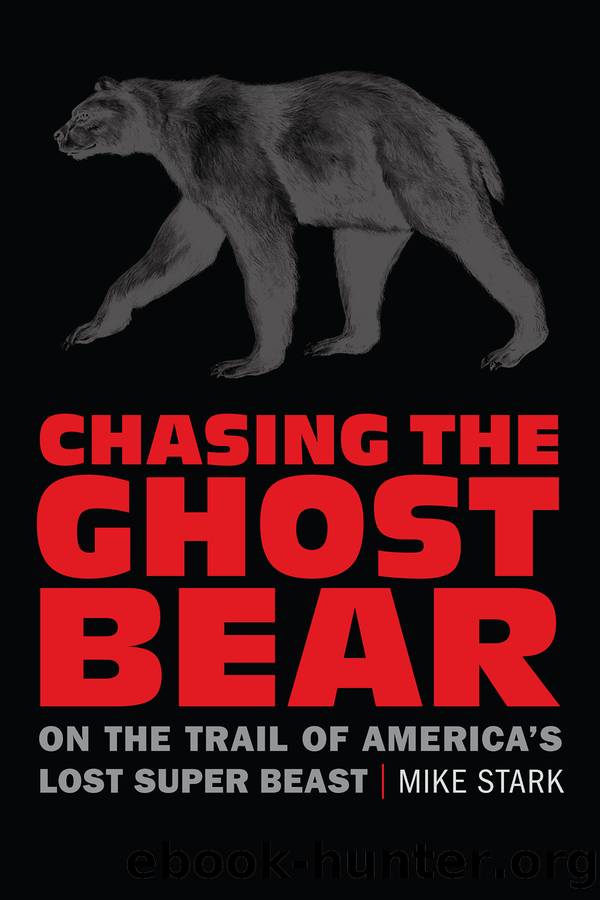Chasing the Ghost Bear: On the Trail of America's Lost Super Beast by Mike Stark

Author:Mike Stark [Stark, Mike]
Language: eng
Format: epub
Tags: NAT003000 Nature / Animals / Bears, SCI054000 Science / Paleontology, NAT015000 Nature / Fossils
Publisher: Bison Books
PART 4
North and South
17
Fitful Arrivals
These days, if youâre a paleontologist digging in a hole and think you mightâve stumbled upon the remains of a giant short-faced bear, the first person youâre likely to call is Blaine Schubert. A native of the Ozarks, Schubert today is a professor at East Tennessee State University and director of the Center of Excellence in Paleontology. Heâs also an expert in the Pleistoceneâand a deep expert on these long-gone bears. âArctodus is one of my favorite animals,â he told me. âTheyâre amazing, terrifying, and mysterious.â
Thereâs a line you can draw about our knowledge of giant short-faced bears that starts with E. D. Cope and his initial work describing the first discoveries, then passes through the University of Californiaâs John Merriam and those looking at La Breaâs earliest excavations in the early twentieth century, followed by Finlandâs Björn Kurténâs work in the 1960s and 1970s, and finally to Schubert in recent decades. Many others have contributed along the wayâthatâs one of the beautiful things about science and discoveryâbut these scientists have provided foundational knowledge that we return to time and again to understand and challenge what we think we know about this great bear. Today Schubert can easily rattle off details of coast-to-coast bear discoveries and offer nuanced answers about whatâs known and not known about short-faced bears. Like the others before him, he loves the gritty details of precision analyses and measurements alongside the imaginative side of paleontologyâtrying to figure out what the days were like for Arctodus, what they ate, how and even where they slept.
But each of those scientists had to start somewhere, and for Schubert the beginning came with an email, a grueling cave expedition in the Ozarks, and a kneecap.
In December 1998 Schubert was working at the Illinois State Museum and got an email from a caver friend, James Kaufmann, a student at the University of Missouri at Rolla. Kaufmann and other members of the schoolâs spelunking club had been mapping a vast cave in Missouriâs Pulaski County. Far inside, caver Andy Free had found the big bones of what Kaufmann suspected was an Ice Age species. It certainly couldâve been a cow or something else quite ordinary, Schubert thought, but what if it wasnât?
A month after the email, Schubert, Kaufmann, and a crew climbed to the entrance of the cave perched high on a bluff above the Gasconade River, a twisty strip of mountain runoff flowing through hardwood forests and along tall cliffs and brushy banks. Despite its seventy-five-foot-wide opening and high ceiling, the cave narrowed into a three-foot-tall crawlway that went on and on. Several trunks veered off to different rooms and still more cramped and twisting hallways. Cavers estimate that the underground network of byzantine passages totals more than four miles. Once inside, the trip was frigid, wet, muddy, and dark, but Schubert loves being underground. He had grown up caving in the Ozarks and elsewhere but still shivers at the memory of the trips to the bear site above the Gasconade.
Download
This site does not store any files on its server. We only index and link to content provided by other sites. Please contact the content providers to delete copyright contents if any and email us, we'll remove relevant links or contents immediately.
Sapiens: A Brief History of Humankind by Yuval Noah Harari(14254)
The Tidewater Tales by John Barth(12609)
Mastermind: How to Think Like Sherlock Holmes by Maria Konnikova(7229)
Do No Harm Stories of Life, Death and Brain Surgery by Henry Marsh(6891)
The Thirst by Nesbo Jo(6832)
Why We Sleep: Unlocking the Power of Sleep and Dreams by Matthew Walker(6618)
Life 3.0: Being Human in the Age of Artificial Intelligence by Tegmark Max(5476)
Sapiens by Yuval Noah Harari(5294)
The Longevity Diet by Valter Longo(5021)
The Body: A Guide for Occupants by Bill Bryson(4976)
The Rules Do Not Apply by Ariel Levy(4863)
The Immortal Life of Henrietta Lacks by Rebecca Skloot(4526)
Animal Frequency by Melissa Alvarez(4395)
Why We Sleep by Matthew Walker(4361)
The Hacking of the American Mind by Robert H. Lustig(4319)
Yoga Anatomy by Kaminoff Leslie(4308)
All Creatures Great and Small by James Herriot(4233)
Double Down (Diary of a Wimpy Kid Book 11) by Jeff Kinney(4208)
Embedded Programming with Modern C++ Cookbook by Igor Viarheichyk(4103)
